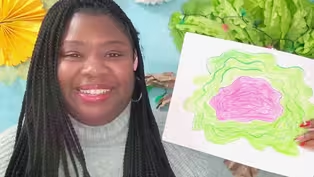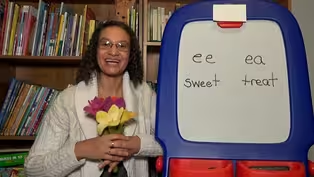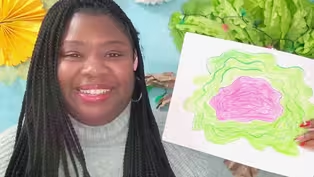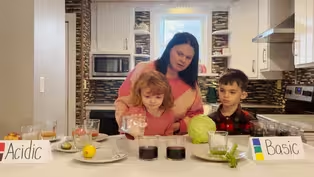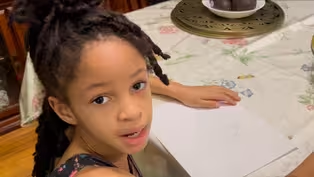
USING TANGRAMS TO MAKE FLOWERS AND TREES
Clip: 5/19/2023 | 9m 57sVideo has Audio Description, Closed Captions
Omar Etman and Lily Fincher show how to use tangrams to make flowers and trees.
Omar Etman and Lily Fincher show how to use triangles, a square, and a parallelogram from a tangram puzzle to make flowers and trees.
See all videos with Audio DescriptionADProblems playing video? | Closed Captioning Feedback
Problems playing video? | Closed Captioning Feedback
Let's Learn is a local public television program presented by THIRTEEN PBS

USING TANGRAMS TO MAKE FLOWERS AND TREES
Clip: 5/19/2023 | 9m 57sVideo has Audio Description, Closed Captions
Omar Etman and Lily Fincher show how to use triangles, a square, and a parallelogram from a tangram puzzle to make flowers and trees.
See all videos with Audio DescriptionADProblems playing video? | Closed Captioning Feedback
How to Watch Let's Learn
Let's Learn is available to stream on pbs.org and the free PBS App, available on iPhone, Apple TV, Android TV, Android smartphones, Amazon Fire TV, Amazon Fire Tablet, Roku, Samsung Smart TV, and Vizio.
Providing Support for PBS.org
Learn Moreabout PBS online sponsorship[upbeat music] - Oh, remember that trip we took with our class to the community garden?
Let's build some of the things we saw there.
- Ooh, yeah.
Oh, I remember we got to push that wheelbarrow full of soil.
Could we build that wheelbarrow?
- Yeah!
[inquisitive music] Great, oh well, and of course there were so many flowers like this one.
- And then we saw the koi pond with so many fish.
Let me show you.
Oh, and on that pond there were water lilies.
- Yeah.
[laughs] And there were so many beautiful trees.
Oh, but wait, we've not made a tree out of shapes yet.
- Hmm.
Friends at home, these shapes that we've been building with, they're called tangrams.
Tangrams are a type of puzzle.
They were invented long ago in China.
They traveled by ship all over the world.
Soon people everywhere were playing with tangrams.
- Yeah, because they're so much fun.
- And because the possibilities are endless.
You can build so many things with these seven shapes.
- Well, let's show our friends about the shapes.
- Yeah, let's do it.
What you need to know about Tangrams is that they're made up of seven specific shapes.
[buoyant music] There are several triangles.
- And we know they're triangles because they have three connected sides.
Let's count all the triangles.
- [Omar] 1, - [Lily] 2, - [Omar] 3, - [Lily] 4, - [Omar] 5, 5 triangles.
And there's a square.
We know it's a square because it has four sides that are all the same length and four square corners.
- [Lily] And a parallelogram.
I love parallelograms.
They have four connected sides and the opposite sides are parallel.
- And look how all seven shapes together form a larger square.
Friends, what do you notice about this larger square?
What do you notice about the triangles inside of it?
How are the triangles the same?
How are they different?
- Fun, well, let's start creating.
What about that tree?
- Well, I bet there are many ways to make a tree using tangrams.
Let's try.
[inquisitive music] - Lily, I have a tangram challenge for you.
Yesterday I made an apple.
Here you go, I outlined all of the shapes for you.
- [Lily] Ooh, look at that big square on the bottom.
Oh, lemme see.
I think it's made of two triangles.
Let me fill them in.
Oh, since I did the large triangles, maybe I'll keep going with the rest.
Looks like the medium triangle goes above that big triangle.
Then the one little one goes above the medium.
Hmm.
And the last little triangle goes on this side.
Oh, I think that's a square.
I better rotate it to fit it in.
Oh, it sit perfectly.
And to end, the parallelogram.
A cute stem made out of a parallelogram.
- Wow, Lily, great job filling in the apple.
I think you're ready for more of a challenge.
This time, I won't outline all seven shapes, just some of them.
A rose for my Lily.
- [Lily] Ooh, that looks hard.
But I can't wait to see how I can figure it out.
Okay, well I think those big petals are the big triangles.
So let me start with that.
Oh, and this cute stem, it has to be a parallelogram.
So now for the center of the rose, I see some corners on top.
Maybe this is the top of a triangle.
Lemme see if the small triangle will fit.
It does.
Let me add the other one.
Hmm.
Wait, that won't work.
Let me start again.
What if I put the square in the center.
And then, maybe the small triangles for the top of these petals?
Oh, and look what's left.
One more space for a triangle.
I did it!
- Nice job, Lily.
I really like how you started with an idea, realized it wouldn't work, and then tried something else.
Great problem solving.
- Thanks, Omar.
Well, what if I make a puzzle for you?
- Oh, okay, that sounds fun.
- I'll make this one super hard.
I've only made the outline of the puzzle.
[playful music] - Hmm.
This is tough.
Friends at home, help me out.
Okay, I see the dog's tail.
Yeah, that's a parallelogram.
Okay, so we have the tail.
What about the body?
I think the back of Dewey's body, it looks like a big triangle.
Yeah, that fits nicely.
Ooh, and his legs, those look like two small triangles.
Hmm.
Something doesn't look right about that front leg.
Let me try a medium triangle.
Yeah.
That's better.
Okay.
And I see that a large triangle would fit right here for Dewey's body.
And then for the head.
Do you see it?
Yeah, a square.
In the final spot, a triangle.
We did it, good job.
Tangrams are so fun, Lily.
Friends at home, if you wanna build the things you see around you using shapes, you can make tangrams too.
You can print or draw a set of tangrams like this and then ask a trusted caregiver to help you cut it out.
That's when the fun begins.
That's when you get to start building with these seven amazing shapes.
[uplifting music] - [Lily] You can make so many things, like a fairy.
- [Omar] A person leaping.
- [Lily] A horse.
Neigh!
- Friends at home, we're gonna keep building with tangrams.
We hope you have fun with tangrams too.
See you later.
- Bye.
Video has Audio Description, Closed Captions
Clip: 6/12/2023 | 7m 31s | Darlene Thomas reads RAINING by Pingping Xu with illustrations by Graca Lima. (7m 31s)
Video has Audio Description, Closed Captions
Clip: 5/19/2023 | 7m 49s | Lia Zuilivia from Studio in a School draws the lines and shapes of a houseplant. (7m 49s)
LONG E SOUNDS SPELLED EE AND EA
Video has Audio Description, Closed Captions
Clip: 5/19/2023 | 8m | Anna Scretching-Cole explores long e vowel sounds spelled with ee and ea. (8m)
Video has Audio Description, Closed Captions
Clip: 5/19/2023 | 7m 31s | Darlene Thomas reads RAINING by Pingping Xu with illustrations by Graca Lima. (7m 31s)
Video has Audio Description, Closed Captions
Clip: 5/19/2023 | 7m 59s | Cassondra Easterling and her children use cabbage water to test the acidity of fruit juice (7m 59s)
Video has Audio Description, Closed Captions
Clip: 5/19/2023 | 11m 37s | Diane Sanlatte teaches a song about the four seasons in Spanish. (11m 37s)
ZURI SHOWS HOW TO DRAW A FLOWER!
Video has Audio Description, Closed Captions
Clip: 5/19/2023 | 59s | Zuri shows how to draw a flower. (59s)
Providing Support for PBS.org
Learn Moreabout PBS online sponsorshipSupport for PBS provided by:
Let's Learn is a local public television program presented by THIRTEEN PBS
